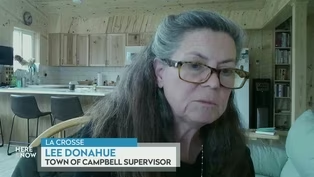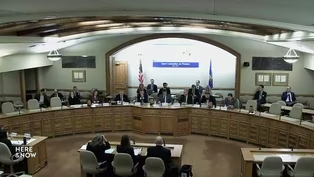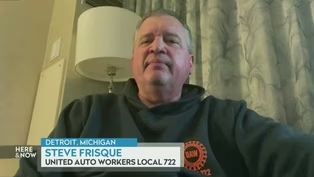Here and Now
Wisconsin's Racial Disparities in Maternal, Infant Mortality
Clip: Season 2200 Episode 2218 | 7m 16sVideo has Closed Captions
Deaths of Black infants, mothers in Wisconsin are shaped by access, biases in health care.
Higher levels of deaths among Black infants and their mothers in Wisconsin are shaped by access to and implicit biases in the health care system, but medical providers are working to improve outcomes.
Problems playing video? | Closed Captioning Feedback
Problems playing video? | Closed Captioning Feedback
Here and Now is a local public television program presented by PBS Wisconsin
Here and Now
Wisconsin's Racial Disparities in Maternal, Infant Mortality
Clip: Season 2200 Episode 2218 | 7m 16sVideo has Closed Captions
Higher levels of deaths among Black infants and their mothers in Wisconsin are shaped by access to and implicit biases in the health care system, but medical providers are working to improve outcomes.
Problems playing video? | Closed Captioning Feedback
How to Watch Here and Now
Here and Now is available to stream on pbs.org and the free PBS App, available on iPhone, Apple TV, Android TV, Android smartphones, Amazon Fire TV, Amazon Fire Tablet, Roku, Samsung Smart TV, and Vizio.
Providing Support for PBS.org
Learn Moreabout PBS online sponsorship[solemn music] - Nathan: The harsh reality is from the first day they're born, Black babies are much less likely to thrive and more likely to die than white infants in Wisconsin.
The same holds true for their mothers.
In fact, this has been true since the first infant and maternal mortality data was gathered in 1912.
- I think one of the big things that people don't realize is that this is a problem that we have identified more than a century ago.
- Nathan: Tiffany Green is a professor for population health sciences at UW-Madison.
She says that while overall, maternal mortality has greatly decreased in the last century, the gap between Black and white mothers and infants has persisted, especially in Wisconsin.
- Tiffany: We still unfortunately have among the highest Black infant mortality rates in the country, meaning Black babies that don't reach their first birthday.
Black birthing people have about five times the pregnancy-related mortality rate relative to their white counterparts in Wisconsin.
- In general, we are leaders in the nation as it relates to many of the inequities that we see.
- Nathan: Dr. Jasmine Zapata is the chief medical officer for community health at the Wisconsin Department of Health Services.
- There's no one answer.
We could talk about this for hours and hours.
It's multifactorial.
- Nathan: Advocates say one potential reason we see disparities is because health care providers can carry implicit biases into the clinic.
- So a lot of times when we talk about implicit bias and talk about racism in our health care system, a lot of people think about, like, direct, interpersonal racism where somebody would come up to me and say, "I don't want you to treat me 'cause you're Black."
That's not a lot of what we see.
A lot of it is unintentional.
- Nathan: Because of those unintentional biases, Zapata says Black people are less likely to go to a doctor when something is wrong, which can lead to worse health outcomes.
- There are many people, especially in the maternal and child health fields, that have access, that have insurance, and they're still not attending their health care appointments.
Just because you have insurance and you can physically make an appointment, is it somewhere that you feel safe and comfortable?
- Nathan: But while access to quality health care can be a large driver in outcomes, national data shows that even the infants of the richest Black mothers suffer worse health outcomes than the babies of the poorest white mothers.
- I think we focus a lot on hospitals and doctors because that is something we can easily wrap our heads around.
But the reality is there are a lot of reasons, and I think they have a lot more to do with the social environment.
- Nathan: And the societal environment for Black Wisconsinites is one defined by racism.
When it comes to where Black Wisconsinites live, only a quarter own their own home.
They face one of the highest income gaps in the country and are five times more likely to live in a food desert than white people.
- A lot of people have linked things like segregation, things like the resource-deprived environments, to the risk of prematurity, and those things matter.
- Nathan: Dr. Zapata says she experienced this difference in outcomes firsthand when she had her second child.
- I got pregnant with my second child, a little baby girl.
I was so excited, and she was due on January 2, but on September 20, I had a sharp pain in my lower abdomen.
- Nathan: When it happened, she was in class for medical school and knew something was wrong.
Doctors told her that it was just false labor, but when she saw blood a few minutes later, she went to the hospital.
- Ultimately, within two hours, I was in an emergency C-section, and I delivered a one and a half-pound baby who didn't cry when she came out.
When babies come out, they're supposed to be kicking, screaming, crying.
It was completely silent.
- Nathan: Her daughter was then taken to the neonatal intensive care unit to start her breathing.
- It was so hard for me at that moment because I knew all the statistics about Black birth outcomes.
- Nathan: After three weeks in the NICU, Zapata's baby was able to thrive and is now a very healthy teenager, but Zapata knew the outcome could have been much different.
- I knew that it was a honor that she was there with me because there are so many other birthing people and families, particularly Black women, Black birthing people who do not have that same outcome.
- There are reasons above and beyond sort of these individual-level characteristics that don't explain why we are seeing these disparities.
- Nathan: But there is work being done to bring parity to birth outcomes for Black mothers and infants.
In 2022, Governor Evers announced $16 million in additional funding for DHS to work on closing those gaps.
- We're currently working on this with intensity and passion.
- Nathan: Dr. Zapata says there are three big things that money is going toward: increasing access to health care for Black mothers and infants, educating current health care practitioners about the issues, and increasing the number of Black doctors and nurses.
- We will have a bigger impact if we can go upstream and focus on how can we eliminate some of the very factors and social determinants of health that cause some of these health outcomes in the first place.
- Nathan: Along with the $16 million, health care providers in Dane County have another effort to improve the social determinants of health called ConnectRx.
ConnectRx is a program that provides support to pregnant Black people at risk.
- Making sure that families at risk of losing their places are getting housing, making sure that they are getting food.
I've heard, been privileged to hear stories about people getting employment that they need.
- Nathan: The program also connects mothers with doulas if they choose, and with an individual community health worker, both during pregnancy and after.
- I'm just stunned at the work that they've been able to do that addresses these social determinants.
- Nathan: But even with these programs, Green says more needs to be done.
- When we talk about things like Medicaid expansion, which we have refused to do in our state, despite the fact that places like Georgia and Mississippi have expanded postpartum Medicaid for up to a year.
- Nathan: The Wisconsin legislature removed Medicaid expansion from the governor's budget again in 2023, making Wisconsin one of only a few states which has not expanded postpartum coverage.
- If we live in a Wisconsin where everybody is able to reach their highest potential, everybody needs access to a provider.
- Nathan: While expanded coverage remains elusive, health officials look to fill the gaps and improve the outcomes wherever they can.
For Here & Now, I'm Nathan Denzin.
Here & Now opening for November 3, 2023
Video has Closed Captions
Clip: S2200 Ep2218 | 1m 5s | The introduction to the November 3, 2023 episode of Here & Now. (1m 5s)
Lee Donahue on Living Amid PFAS Pollution on French Island
Video has Closed Captions
Clip: S2200 Ep2218 | 5m 13s | Lee Donahue on hazardous levels of PFAS in water sources and a lawsuit against La Crosse. (5m 13s)
Republicans React to Evers Lawsuit Over Joint Committees
Video has Closed Captions
Clip: S2200 Ep2218 | 6m 19s | Republican lawmakers react to lawsuit over joint committees separation of powers. (6m 19s)
Steve Frisque on the UAW Settling Its Strike of Automakers
Video has Closed Captions
Clip: S2200 Ep2218 | 5m 24s | Steve Frisque on the UAW's deal with GM, Ford and Stellantis to end a weeks-long strike. (5m 24s)
Providing Support for PBS.org
Learn Moreabout PBS online sponsorship
- News and Public Affairs

Top journalists deliver compelling original analysis of the hour's headlines.

- News and Public Affairs

FRONTLINE is investigative journalism that questions, explains and changes our world.












Support for PBS provided by:
Here and Now is a local public television program presented by PBS Wisconsin



